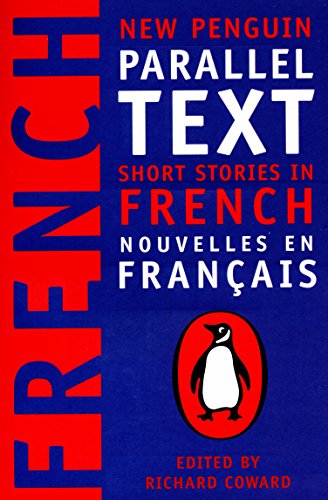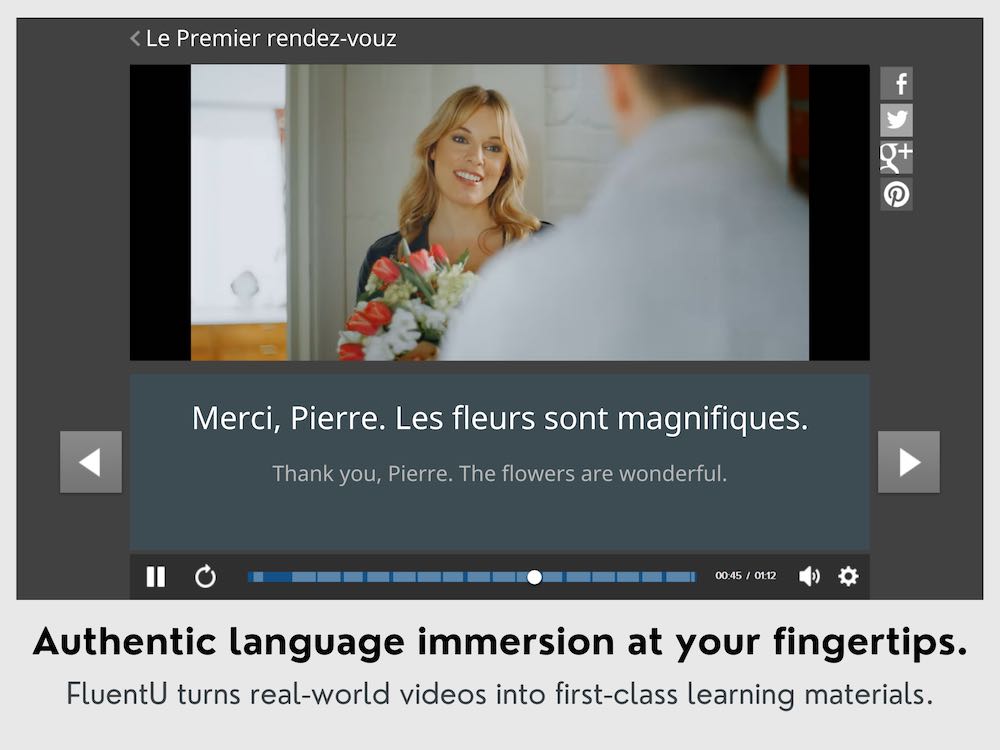
17 French Parallel Texts to Read Books in French and English
For the longest time, I wished there was a way to read French books without checking a dictionary every few seconds.
Luckily, there’s a type of book that makes the whole thing much easier: parallel texts in French and English.
Essentially, these are bilingual books that have the same content in both languages—which was definitely a game-changer for me!
Now, I want to share with you 17 parallel texts from different types of books that I hope will open up a world of French reading for you, too.
Contents
- What Is a Parallel Text?
- 17 Fun Books with Parallel Text in French and English
- Short Stories
- Classic Literature
- 3. “Le Comte de Monte-Cristo” (“The Count of Monte Cristo”)
- 4. “Candide”
- 5. “Les Aventures d’Alice au pays des merveilles” (“Alice’s Adventures in Wonderland”)
- 6. “Le tour du monde en 80 jours” (“Around the World in 80 Days”)
- 7. “Les Trois Mousquetaires” (“The Three Musketeers”)
- 8. “Le Médecin malgré lui” (“The Doctor in Spite of Himself”)
- Fairy Tales
- Poetry
- Children’s Books
- How to Find French Bilingual Books
- Who Should Read Parallel Texts?
- And one more thing...
Download: This blog post is available as a convenient and portable PDF that you can take anywhere. Click here to get a copy. (Download)
What Is a Parallel Text?
Remember geometry class where you learned about parallel lines? They’re lines that are on the same plane but never touch.
“Parallel text” refers to a body of text that includes translations of two different languages right next to each other.
In this case, part of the book is in French, immediately translated into English. Depending on the book, you can read the English translation by page, by paragraph or even by sentence. This means you won’t have to constantly look up the meanings of French words online.
I think this is fantastic because, if you’re like me, jumping online only leads to scrolling through Facebook and Reddit!
Let’s get into some French-English parallel texts that will not only hone your language skills but also let you have fun.
17 Fun Books with Parallel Text in French and English
Short Stories
Working your way through a collection of short stories is a great way to build your French vocabulary. When you read multiple stories, you diversify the information you take in.
Short story collections may also hold your attention longer than a book. If one story is too difficult or easy, just move on to the next one!
You have the added advantage of exposing yourself to many new foreign authors you never would’ve read otherwise—a major bonus for all my fellow bibliophiles!
1. “Short Stories in French”
This compilation is made up of 12 short stories by both French and Québécois authors. The vocabulary and storytelling techniques differ depending on the narrative.
The book opens with the story “Apprendre à Vivre” (“Learning How to Live”) by Frédéric Fajardie. This is a tale of a young boy and a man whose lives briefly intersect before one of them dies.
At the time the story takes place, both characters’ lives revolve around love. You’ll learn terms related to romance and heartbreak, such as un amant (lover) and la femme (wife).
After reading this first story, I guarantee you’ll be hooked on this book.
These tales will teach you how to use French past tenses including l’imparfait and le passé simple when telling a story. You’ll also pick up on humor and tone as you read various examples of great French writing.
2. The “Learn French Parallel Text” Series
That’s right, there’s an entire series based on the parallel text teaching philosophy!
You can start at the beginning and work your way through each volume. Or maybe you’d rather choose one book that best fits your level and goals.
“Learn French I Parallel Text: Easy Stories” is a solid place for beginner students to start to learn through parallel text.
“Learn French II Parallel Text: Short Stories” is the next step for intermediate learners.
“Learn French III Parallel Text: Easy to Moderately Hard Short Stories” is good for a variety of learners. If you think parallel text is a helpful learning tool, get this book and work your way through the stories as your French improves.
“Business French Parallel Text” is a wonderful option for advanced students and/or learners who know they want to use French in their professional lives. This book still contains short stories, but the tales involve business information and vocabulary.
Classic Literature
You may already be familiar with some of these classic books. Read them with a fresh perspective as you take in the story in both French and English.
3. “Le Comte de Monte-Cristo” (“The Count of Monte Cristo”)
“The Count of Monte Cristo” is a classic novel by French author Alexandre Dumas. It’s only fitting that you read this tale in French, because the story takes place in Paris.
For readers who thought Monte Cristo was just the name of a delicious sandwich, here’s a brief synopsis of the work:
Edmond Dantès is an innocent man who was unjustly imprisoned for 14 years. He was convicted of committing treason. “The Count of Monte Cristo” is the story of his revenge on the men who imprisoned him.
Imagine if Jean Valjean from “Les Misérables” plotted to carry out vengeance against Inspector Javert rather than going on to lead a productive life, and you pretty much have the plot of “The Count of Monte Cristo.”
Reading this book, you’ll learn vocabulary related to law and class. For example, you’ll come across words such as l’émigré (emigrant) and l’interrogatoire (interrogation).
You’ll also familiarize yourself with numerous occupations, from l’armateur (shipowner) to le procureur (prosecuting attorney).
4. “Candide”
“Candide” is a famous book by one of the most well-known French authors of all time, Voltaire. It was published in the 18th century, so this piece should appeal to major book lovers who can stand to read text in the “old language”—both in French and English.
Candide is a young man raised to be an optimist by his mentor, Professor Pangloss. Throughout the story, Candide faces many hardships and starts to slip away from optimism. This summary sounds tragic, but keep in mind as you read that this book is satire!
“Candide” introduces readers to vocabulary related to philosophy. You’ll notice terms such as l’optimisme (optimism), la philosophie (philosophy) and croire (to believe).
5. “Les Aventures d’Alice au pays des merveilles” (“Alice’s Adventures in Wonderland”)
When you read “Alice’s Adventures in Wonderland,” you kill two birds with one stone. Although it was originally written in English, you still get to experience a classic tale in French and reconnect with your inner child!
This is the story of a little girl who falls down a rabbit hole and finds herself in Wonderland, an alternate universe where she meets colorful characters and gets herself into some sticky situations.
“Alice in Wonderland” is one of the classics that should not be reserved for advanced students alone. Beginner and intermediate students can follow along easily. The vocabulary isn’t too difficult and with the parallel text to assist you, reading this literary staple is quite manageable.
Beginners benefit from learning names of animals in French, such as le lapin (rabbit) and la souris (mouse).
Intermediate learners can familiarize themselves with French translations for classic fairy tale characters. Read about le chapelier fou (The Mad Hatter), La Reine de Cœur (Queen of Hearts) and le chat du Cheshire (Cheshire Cat).
6. “Le tour du monde en 80 jours” (“Around the World in 80 Days”)
“Around the World in 80 Days” is more than just a Jackie Chan movie! Years before the film was released, it was a famous book by Jules Verne.
This book tells the story of Phileas Fogg, a rich man who bets his friends 20,000 pounds that it’s possible to travel around the entire world in only 80 days. He takes his French servant, Passepartout, to help him make good on his bet.
As you can imagine, this tale includes a lot of vocabulary related to travel. Readers will learn the French names for numerous countries, including l’Inde (India), la Mongolie (Mongolia) and l’Angleterre (England).
You’ll also pick up on common travel terms, such as la gare (train station) and le bateau à vapeur (steamer).
7. “Les Trois Mousquetaires” (“The Three Musketeers”)
Meet swordsman d’Artagnan and his comrades Aramis, Porthos and Athos. This swashbuckling quartet has inspired a plethora of international works including anime, television series, video games, a musical and a chocolate candy bar.
Set during the l’Ancien Régime (the Old Regime) that lasted from the 16th century up to the French Revolution, the book was essentially a critique of the reigning government at the time. It’s far from a boring history book, though: You’ll root for our aforementioned and titular protagonists as they go into all sorts of exciting adventures.
Since I want you to experience that excitement for yourself, I will definitely not spoil any important plot points. (Not that its countless adaptations haven’t already done that anyway!)
Be aware, though, that you’ll need to have an advanced grasp of French to get through this book in its original language. That’s because it uses a ton of archaic grammar rules and words that’ll leave you scratching your head. There are also words that aren’t used the way you’d expect like Dame—which was apparently a curse word and not a way to address a lady!
8. “Le Médecin malgré lui” (“The Doctor in Spite of Himself”)
If you like your classic literature with a generous dollop of (dark) comedy, you’ll love this one!
Penned by Molière (a.k.a. Jean-Baptiste Poquelin), one of the giants of French literature, it’s a farce about Sganarelle, whose wife Martine wanted to take revenge on him for beating her up during a fight.
Martine’s revenge wasn’t what you’d call “conventional,” though: When she meets a couple of men looking for a doctor for their master, she tells them that Sganarelle is exactly who they’re looking for. She also tells them that he’s a rather strange man who wouldn’t say he’s a doctor until he’s been beaten up. (You can see where this is going!)
Many of the comedic devices in “Le Médecin malgré lui” will be familiar to filmgoers and sitcom viewers. Although the events may seem too ridiculous to be believable, you still can’t help but split your sides open with laughter.
Much like his predecessor Shakespeare did in English, Molière introduced words and expressions into the French language that are still widely used over three centuries later. On the other hand, if you’re also studying Latin and are reading this book, be warned: Much of the Latin the “doctor” uses is—shall we say—taken from the planet Uranus.
Fairy Tales
Contes de fées (fairy tales) are an important part of the French cultural lexicon. These bilingual books can open an enchanted door into French language, history and folk culture.
The familiar stories and characters make it easier to focus on French. Vivid and visceral, the powerful imagery touches your imagination and sparks your emotions. Go beyond the book and film adaptations—get the real story when you read the French original.
9. “Ali Baba et les quarante voleurs” (“Ali Baba and the Forty Thieves”)
“Ali Baba and the Forty Thieves” is a folktale most of us have heard of but probably never read. In fact, when I hear the title of this story, my mind automatically jumps to the lyrics of “Never Had a Friend Like Me” from Aladdin.
In this story, Ali Baba is a poor woodworker who discovers a den of treasures that belongs to evil thieves. When they find out that he knows about their secret, they set out to kill him. I won’t spoil the ending, but don’t worry, nothing too terrible happens to poor Ali Baba!
A lot happens in this short story, so there are plenty of useful French verbs. You’ll find conjugated forms of the words entendre (to hear), habiter (to live), pouvoir (to be able) and acheter (to buy), among others.
As an added bonus, this is the main story that popularized the saying “Open, Sesame!” In French, this translates to Sésame, ouvre-toi! Have fun using that one on automatic doors.
10. “La Belle et la bête” (“Beauty and the Beast”)
While you’ve probably seen the Disney movie “Beauty and the Beast,” you may have never read the book by Jeanne-Marie Leprince de Beaumont.
Unfortunately, there aren’t any magical singing candlesticks or feather dusters in the book. (I know, I was disappointed, too.)
Reading “Beauty and the Beast” gives learners insights into vocabulary used in fairy tales. For example, you’ll see words such as le château (castle), le prince (prince), la fée (fairy) and la malédiction (curse). All good fairy tales have curses!
For all you visual learners out there, this book is especially great. The copy sold on Amazon has illustrations and these pictures could help you remember the new French terms.
11. “Cendrillon” (“Cinderella”)
Like “Beauty and the Beast,” “Cinderella” is another fairy tale about a commoner-turned-princess set in France that was adapted into a Disney movie.
In fact, between the two stories, “Cinderella” is the one that’s more likely to come up in a conversation on fairy tales people are most likely to associate with France!
In this bilingual edition, you can see breathtaking illustrations of Charles Perrault’s original text. (In case you didn’t know already, Perrault is to France what Hans Christian Andersen was to Denmark: A collector and author of folk tales-turned-literary classics).
Most importantly, there are side-by-side French-English renderings of Perrault’s original text. You’ll also find the fairy tale vocabulary I mentioned earlier in this book. And since it’s only 60 pages long, you can read it along with (or to) your kids!
12. “Learn French with Fairy Tales: Interlinear French to English”
Can’t decide which fairy tale you want to sink your teeth into? In that case, you might want to grab a copy of this collection of nine fairy tales, which includes “Les Trois Ours” (The Three Bears) and “Blanche-Neige” (Snow White).
Each line of a given story is presented first in large, boldfaced French—with word-for-word, literal English translations right underneath the French. You’ll also see English idiomatic equivalents for some words and phrases. Thanks to this format, you can see some interesting grammatical differences between the original French and the English translation.
For example, if you translate the phrase “J’ai faim” literally, it would be “I have hunger” instead of “I am hungry.” These translations are stacked together, so you can easily see any distinctions in meaning that you should take note of as a French learner.
One good way to learn with this book is to cover the English translations with a piece of paper, challenge yourself to read the book entirely in French and remove the piece of paper to see if your reading or translation is accurate!
Poetry
Once you’ve mastered French prose, the logical next step is French poetry. After all, poems showcase the rhythm and cadence of a language. When you go through these bilingual editions of French poems, you can savor things like metaphor and subtle shades of meaning—not to mention compare and contrast how these work between the two languages.
13. “Selected 19th Century French Poetry, Baudelaire, Rimbaud, Gautier, deLisle, Heredia”
Post-revolution France did not only give rise to imperialist ambitions. The 19th century also produced some of France’s finest poets.
Among these is Charles Baudelaire, famous for “Les Fleurs du mal” (The Flowers of Evil). In fact, the title of that poem inspired a manga-turned-anime of the same name—although that’s honestly the extent of their similarity.
Another poet in the collection, Théophile Gautier, helped pioneer l’art pour l’art (“art for art’s sake”)—a concept still with us today. (I’m sure that, at some point, you’ve been involved in a debate on whether art should be monetized or is something that can only stay “pure” if it’s not tainted by money in some way.)
In this book, the poems are arranged such that the complete French originals are followed by their full English translations. This makes sense, as a word-for-word or line-by-line translation would make it difficult to appreciate the beauty of the poems in both languages.
14. “Préversities: A Jacques Prévert Sampler”
If you want to move one century ahead and pick up an entire collection from a single poet, you can’t go wrong with Jacques Prévert.
Contrary to what you’d expect from a poet, Prévert’s works are surprisingly easy to understand. In fact, his poetry is taught to French schoolchildren. He also left a lasting legacy on the English-speaking world through his poem “Les feuilles mortes” (The Dead Leaves), which became the English-language song “Autumn Leaves.”
This is a hefty book with no less than 410 pages. But because Prévert’s poems are pretty accessible, you don’t have to worry about slugging through pages and pages of mystifying verse. I daresay you’ll even learn to enjoy poetry after reading this book (if you don’t already)!
What makes Prévert’s poems stand out is that, despite their simplicity, they still have the rhythm and beauty characteristic of poetry in general. Like most good poets, Prévert will leave your worldview sideways after reading his work—even if only for a little while.
Children’s Books
Kids’ books are great learning resources for children who are being raised bilingual.
However, these books aren’t exclusively for children! Kids’ literature is a valuable resource for beginners of all ages. If “Alice in Wonderland” seems a bit too hefty for you, grab one of these shorter, fun stories.
15. “My First French Book”
If you’re a complete beginner or you have a young child who wants to learn French, this picture dictionary is a charming way to learn the basics.
In this book, you’ll find words and phrases related to animals, fruits, shapes, numbers, seasons, colors, transportation and so much more.
Each word or phrase is introduced with a brightly-colored picture accompanied by the English word and boldfaced French equivalent. A glossary at the end of the book recaps all the words you learn.
As the book’s title suggests, if you don’t even know an iota of French, this cute tome is a great place to start!
16. “10 Bed-Time Stories in French and English”
These 10 stories are targeted towards kids from eight to 12 years of age. It’s the perfect book for children growing up bilingual, as well as adults in the early stages of studying French.
After each French-language paragraph, you’ll find the English translation of the same text. This paragraph-by-paragraph breakdown makes reading the material digestible for early learners.
When you buy this book online, you also receive an audio recording of all the stories. This perk is great for students who want to hear the correct pronunciation of French words.
Story topics include vacation, school, animals and birthdays. Readers are sure to learn a wide range of basic, useful vocabulary.
17. “Eau-Water”
 Café (Coffee) and Thé (Tea) battle for supremacy, not realizing they must credit Eau (Water) with their very existence! This quirky book, part of a wacky bilingual series by author Miley Smiley, will put un sourire (a smile) on your face as you improve your French.
Café (Coffee) and Thé (Tea) battle for supremacy, not realizing they must credit Eau (Water) with their very existence! This quirky book, part of a wacky bilingual series by author Miley Smiley, will put un sourire (a smile) on your face as you improve your French.
If you feel your French is above the beginner level but slightly below the intermediate level, this one makes for decent reading practice. Instead of word-for-word translations, you’ll find paragraph-for-paragraph translations. This format forces you to put the beginner words you’ve learned in context—and pick up some basic grammar and added vocabulary along the way.
FluentU takes authentic videos—like music videos, movie trailers, news and inspiring talks—and turns them into personalized language learning lessons.
You can try FluentU for free for 2 weeks. Check out the website or download the iOS app or Android app.
P.S. Click here to take advantage of our current sale! (Expires at the end of this month.)
How to Find French Bilingual Books
Many publishers offer bilingual books. This small sampling will give you an idea of the variety of subjects and formats available to you.
- Milet Publishing. Based in Britain, Milet Publishing also has a U.S. website with bilingual offerings primarily geared at children. Topical picture dictionaries comprise most of their catalogue.
- Black Widow Press. Get bitten by the poetry bug with these collections of bilingual French poetry. You can buy them directly from the publisher or on Amazon. If you cast your web wider, you can find them at brick-and-mortar stores throughout the United States and the rest of the world.
- Doppeltext. A purveyor of venerable works in electronic form, Doppeltext’s e-books are priced by length. You can read a free excerpt of every book. For example, Doppeltext offers Guy de Maupassant’s groundbreaking horror story, “Le Horla,” in its entirety. For a “pop-up” translation into English, just click or tap on a phrase or sentence in the original French text.
- Folio bilingue. French publisher Folio’s bilingual book imprint features a wide range of Anglophone authors, including Arthur Conan Doyle and Jack Kerouac. Folio bilingue books are available as paperbacks, and not in electronic format.
Who Should Read Parallel Texts?
Visual Learners
French is a tricky language for us visual learners. Being one myself, the silent letters freak me out. Seven years into my French studies, I still have to stop and think before typing the word beaucoup (a lot).
If someone tries to teach me a new French word simply by speaking it, I’m completely lost! The sounds themselves mean nothing to me.
Additionally, let’s say I know how a French word is spelled but don’t know the definition. If someone tells me the English translation, I easily forget the meaning if I don’t see the English word written down.
If someone says the word and shows me the text in both languages, then I’m on board!
Children Being Raised Bilingual
It’s no secret that reading to your kids daily is beneficial. Storytime builds children’s vocabulary, helps them develop speech and squeezes in some quality time with you every day.
If you’re raising a child to be bilingual and they’re learning to read, work through a children’s book with them that has parallel text.
Note: if you’re raising your child bilingual from a very young age, I recommend sticking to just one language while reading so they can have an immersive experience. If you’re starting to teach them French after they’ve already learned some English, though, having the parallel text handy can be very helpful.
Beginner and Intermediate Learners
If you’re a beginner French learner, the idea of reading an entire book in French may seem beyond your reach.
Thanks to parallel texts, you can venture outside your comfort zone and grab a French book off the shelf. If you start to feel lost, just glance at the English translation. This will help you learn countless new words.
If you’re an intermediate student, aim to read some of the more difficult books in parallel text form. You’re bound to find some new words and ideas that’ll challenge you.
Advanced Learners Trying to Stretch Themselves
Is your French vocabulary on point? Does reading a French children’s book sound way too easy?
Don’t worry, books with parallel text can still benefit you.
Maybe you’ve been shying away from long, difficult texts because they seem a little out of your wheelhouse. Sure, you can discuss current-day politics in French. But reading about 18th-century French politics? That’s a little intimidating!
That’s where parallel text comes in. As seen in the above books, you can find even complex, literary works in parallel text form. Now you can become even more fluent! There’s always room for growth.
These books with parallel text in French and English will save you a lot of time and effort. Now you won’t struggle to make it through a page of French text. And you won’t have to run to a dictionary for help with every third word!
Download: This blog post is available as a convenient and portable PDF that you can take anywhere. Click here to get a copy. (Download)
And one more thing...
If you like learning French on your own time and from the comfort of your smart device, then I'd be remiss to not tell you about FluentU.
FluentU has a wide variety of great content, like interviews, documentary excerpts and web series, as you can see here:
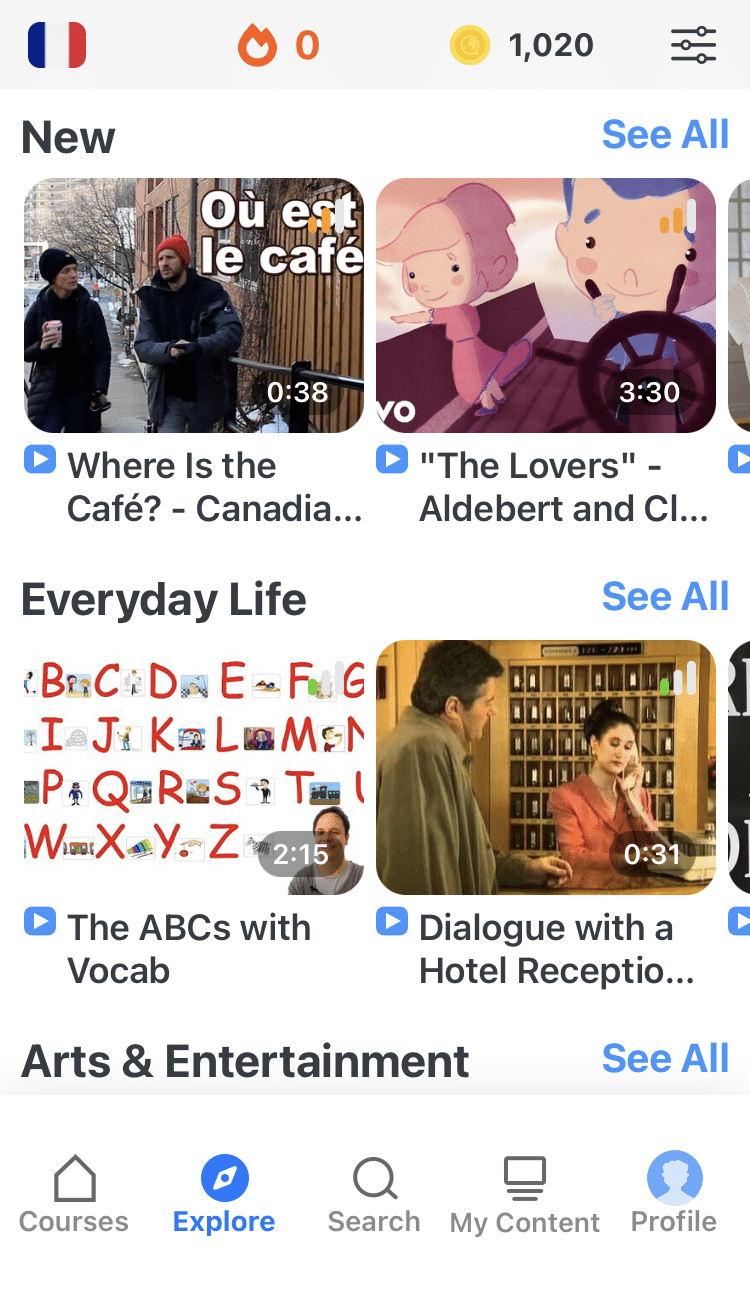
FluentU brings native French videos with reach. With interactive captions, you can tap on any word to see an image, definition and useful examples.
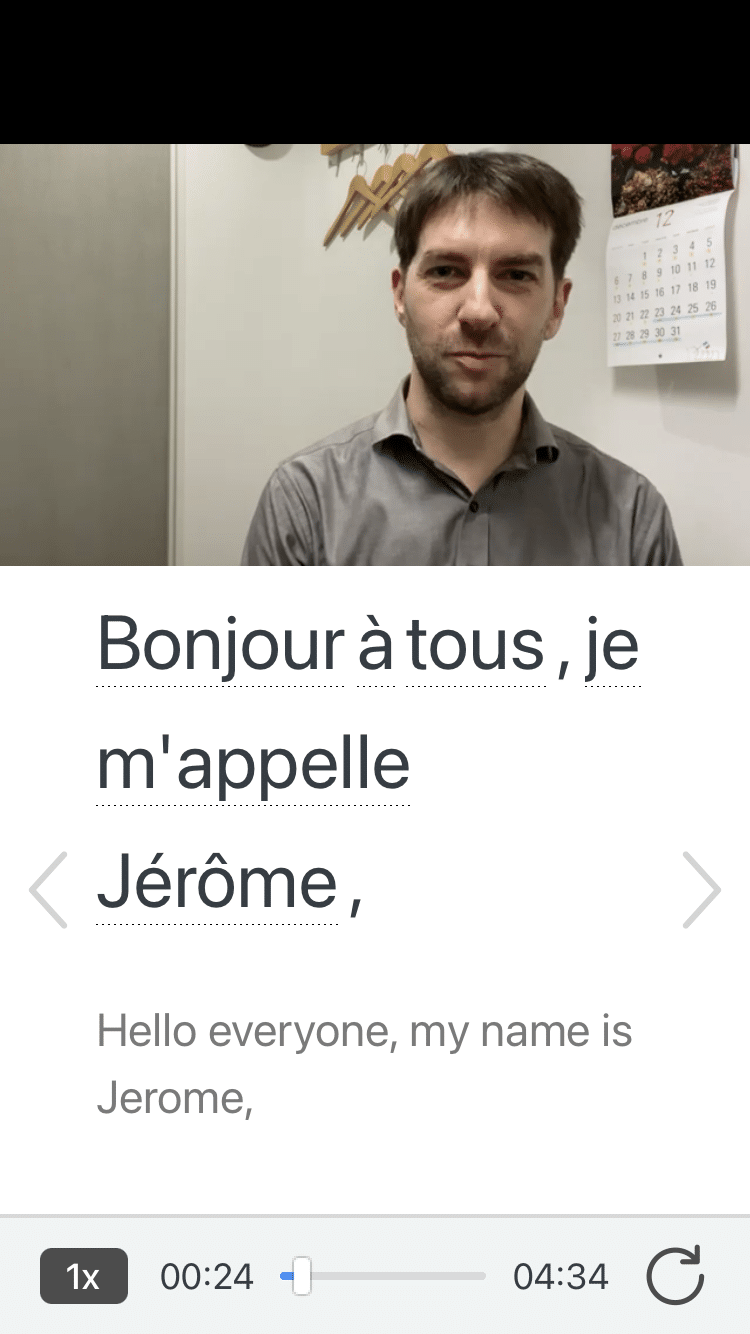
For example, if you tap on the word "crois," you'll see this:
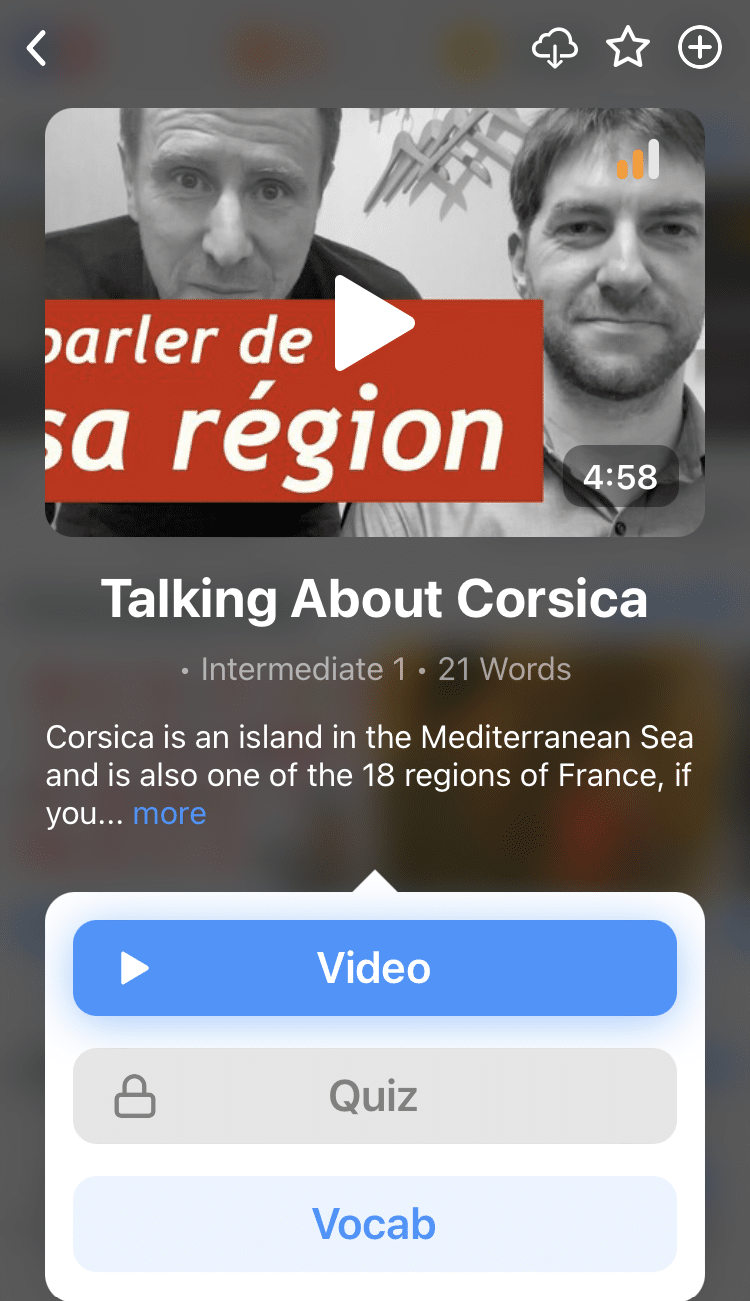
Practice and reinforce all the vocabulary you've learned in a given video with learn mode. Swipe left or right to see more examples for the word you’re learning, and play the mini-games found in our dynamic flashcards, like "fill in the blank."

All throughout, FluentU tracks the vocabulary that you’re learning and uses this information to give you a totally personalized experience. It gives you extra practice with difficult words—and reminds you when it’s time to review what you’ve learned.
Start using the FluentU website on your computer or tablet or, better yet, download the FluentU app from the iTunes or Google Play store. Click here to take advantage of our current sale! (Expires at the end of this month.)
